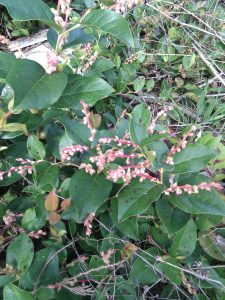Salal is the last traditional food plant I will discuss for this month. I found salal (Gaultheria shallon) among the cedar trees just steps from our property. This sturdy evergreen shrub grows along the Pacific coast where it spreads quickly to form dense thickets. It loves to grow in coniferous forests from the seashore to rocky bluffs but prefers medium to low elevations. The white or pink flowers bloom in late spring and are said to attract hummingbirds, but all I have seen are bees.
The fruits are plentiful and delicious and it is an important fruit for the Northwest Coast First Nations peoples. Its dark, juicy berries were eaten fresh or dried into cakes. For feast occasions the Kwakwaka’wakw ate them dipped in oolichan grease at large feasts [See Grease! for more information about ooligan/oolichan]. For trading or selling, the salal berries were mixed with berries of other northwest native plants such as currants and elderberries. They were also used to sweeten other foods. The Haida used salal berries to thicken salmon eggs. Today the berries are still prepared as jam or preserves and eaten fresh. The leaves are used to flavor fish soup and the leafy branches were used to support meats in cooking.[i]
Salal leaves have a long history as a medicine for wounds, coughs, colds and digestive problems. The Klallam, Bella Coola and Quileute People have chewed salal leaves and applied them on burns and sores. The Samish and Swinomish People have used the leaves for coughs and tuberculosis, while the Quinault People have used them for diarrhea and flu-like symptoms. The young leaves were chewed as a hunger suppressant by the Ditidaht.[ii].
A recent study on salal by David Constabel, a plant biologist at the University of Victoria was highlighted in the news[iii]. He and his colleagues found that salal berries contain two key compounds: tannins, which are found in plant tissues such as leaves and bark, and anthocyanins, which produce red or blue colours in certain plants. Both are found in greater concentration than blueberries and both are correlated with a reduced risk of stroke and heart attack, as well as neurodegenerative and metabolic disease such as Type 2 diabetes.[iv]
The leaves of salal are evergreen and thick with a waxy shine and they stay green for months after being cut, a quality that has made them popular among commercial florists. This has led to extensive harvesting of salal as a “special forest product” throughout the Pacific Northwest including British Columbia.
Special forest products are products or natural resources that are not traditional timber and fiber products. A 2010 study estimated the annual value of salal from southern Vancouver Island alone at between $6.5 million and $10.5 million[v]. This is around a quarter of the provincial total. The salal harvest has greatly increased and as a special forest product, it is an unregulated industry with no rules or policies in place to protect the species.
Questions have been raised regarding whether salal will soon become a rare, threatened, or endangered species because of aggressive harvesting with no regard for its availability, rates of reproduction, or its use by indigenous peoples. There’s little threat that such an abundant species would be wiped out; however, people who make a living harvesting on Vancouver Island are finding that near the end of the season there’s not enough commercial-quality salal left to pick[vi]. As well, no one knows what impact the removal of “special forest products” is having on animals and other plants in the forest, or First Nations berry harvesting. Traditional plant experts such as Dr. Nancy Turner advocate for considering traditional harvesting protocols and practices when developing sustainability guidelines and policies. [vii]
[i] Hansen’s Northwest Native Plant Database, http://www.nwplants.com/business/catalog/gau_sha.html; http://freshroots.ca/blog/Salal-native-plant-want-know/
[ii] http://wildfoodsandmedicines.com/Salal/; http://freshroots.ca/blog/Salal-native-plant-want-know/; Turner, N.J. (1995). Food plants of coastal First Peoples (No. 34., pp. 77-78). UBC Press; Peña, D. (2013, January 10). Salal: Food Medicine and Culture of the Coast Salish Peoples, Good Food World. http://www.goodfoodworld.com/2013/01/salal-food-medicine-and-culture-of-the-coast-salish-peoples/
[iii] http://www.cbc.ca/news/canada/british-columbia/blueberries-superfoods-Salal-berries-uvic-antioxidants-tannins-1.4565091
[iv] Ferguson, A., Carvalho, E., Gourlay, G., Walker, V., Martens, S., Salminen, J. P., & Constabel, C. P. (2018). Phytochemical analysis of salal berry (Gaultheria shallon Pursh.), a traditionally-consumed fruit from western North America with exceptionally high proanthocyanidin content. Phytochemistry, 147, 203-210. https://www.sciencedirect.com/science/article/abs/pii/S0031942218300025
[v] Hobby, T., Dows, K., & Mackenzie, S. (2010). Commercial Development of Salal on South Vancouver Island. Journal of Ecosystems and Management, 11(1 & 2) http://www.jem-online.org/forrex/index.php/jem/article/view/57
[vi] Efron, S. (2004, December 9). Marketing of Forest Floor has Consequences. Georgia Straight. https://www.straight.com/article/marketing-of-forest-floor-has-consequences;
Peña, D. (2013, January 10). Salal: Food Medicine and Culture of the Coast Salish Peoples, Good Food World. http://www.goodfoodworld.com/2013/01/salal-food-medicine-and-culture-of-the-coast-salish-peoples/;
Wakefield, J. (2013, August 25). Shrub at center of BC backwoods ‘black market.’ Business in Vancouver. https://biv.com/article/2013/08/shrub-at-centre-of-bc-backwoods-black-market
[vii] Turner, N. J. (1999). “Keeping it Living”: Applications and Relevance of Traditional Plant Management in British Columbia to Sustainable Harvesting of Non-timber Forest Products. Forest communities in the third millennium: Linking research, business, and policy toward a sustainable non-timber forest product sector, 1, 66. https://www.fs.usda.gov/treesearch/pubs/44703
Turner, N. J. (2001). ” Doing it right”: Issues and practices of sustainable harvesting of non-timber forest products relating to First Peoples in British Columbia. Journal of Ecosystems and Management, 1(1). http://citeseerx.ist.psu.edu/viewdoc/download?doi=10.1.1.551.7126&rep=rep1&type=pdf

